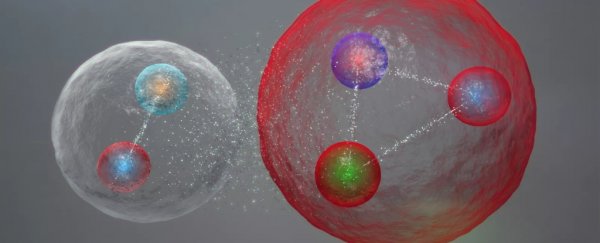New results from the Large Hadron Collider have confirmed it. The mysterious five-quark subatomic particle - the pentaquark, only discovered a few years ago - really is composed of two sets of quarks.
One is a meson, a type of particle that contains a quark and antiquark pair; the other is a three-quark baryon: the subatomic particle that makes up most of the normal matter in the Universe, including protons and neutrons.
This confirms that quarks aren't just chucked together like a loose bag of marbles, but instead are structured more similarly to the way protons and neutrons are bound in an atomic nucleus - what the researchers call a 'molecular' state.
Previously, our understanding of these short-lived particles was based on data collected during the first observing run of the Large Hadron Collider (LHC). This is where, for the first time, particle physicists observed two pentaquarks, Pc(4450)+ and Pc(4380)+
The number in the particle's name refers to its mass in megaelectron volts, and these were whoppers, coming in at over four times the mass of a proton. After studying these masses, the team could only conclude they were created by five quarks.
Quarks come in six 'flavours' or types: up, down, top, bottom, charm, and strange; each of these flavours has an antimatter equivalent. The team determined that pentaquarks are each made up of two up quarks, one down quark, one charm quark, and one anti-charm quark - although how they were arranged remained something of a mystery.
The new results, reported earlier this year and now published in a paper, refine our knowledge of what goes where in a pentaquark - as well as the different masses of pentaquarks themselves.
With LHC's second observing run completed, the team had nine times the amount of collision data.
In it, they found not just a new lower mass pentaquark - Pc(4312)+ - they also found that the Pc(4450)+ mass range covers two overlapping, but separate pentaquarks, Pc(4440)+ and Pc(4457)+.
So, in total, that makes four pentaquarks - Pc(4312)+, Pc(4440)+, Pc(4457)+ and Pc(4380)+. And the first three are consistent with the masses of three separate candidate meson-baryon pairings, accounting for the energy required to bind the particles together.
Of course, it is possible that the pentaquark masses could occur with a different internal structure, and it's just coincidental that they so neatly line up with meson-baryon masses, but that is less likely.
It's also possible that the pentaquark molecular state isn't the only architecture for these particles, and there might be even weirder ones yet to be discovered.
More research and data will, of course, help unravel the mystery. For instance, a separate team of physicists has already determined that the molecular model implies the existence of four previously undiscovered pentaquark masses - perhaps more collision data could help find them.
The research has been published in Physical Review Letters.
